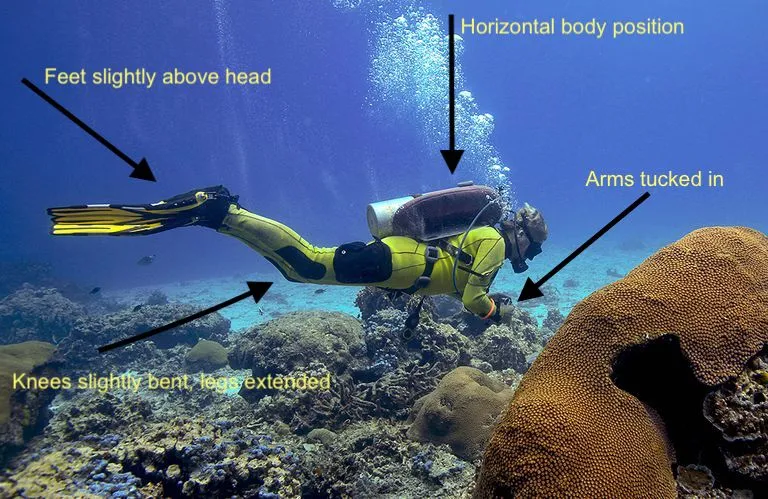Buoyancy Control: Scuba Dive Like a Pro

Let’s revisit Chapter 1 of your PADI Open Water Diver course momentarily. What exactly is neutral buoyancy control? It’s the incredible sensation you aim to achieve while scuba diving, bringing you as close to the experience of an astronaut as possible. Neutral buoyancy occurs when an object’s weight equals the weight of the fluid it displaces, causing it to neither float nor sink. So why discuss neutral buoyancy? Unfortunately, many certified divers lack adequate buoyancy control, and I feel compelled to address this issue, even at the risk of sounding like a repetitive dive instructor.
This short tutorial blog discusses how to achieve proper neutral buoyancy. Access to insider tips and tricks usually comes at a cost, but today, I am sharing some extreme knowledge in the hope that divers will read this Blog and put these methods into practice. As visitors to a sensitive ocean environment, we are responsible for leaving a dive site the way we find it. Protecting the coral reef starts with good buoyancy habits.
3 Expert Buoyancy Control Tips
Tip #1: Dive Properly Weighted
 Divers use lead weights to achieve neutral buoyancy underwater. The weight you need to carry depends on several factors, including your scuba diving experience level, body weight, and the thickness of your wetsuit. Muscle density can also play a role in determining how much weight is necessary. Generally, the more you weigh, the more weight you will need to dive comfortably.
Divers use lead weights to achieve neutral buoyancy underwater. The weight you need to carry depends on several factors, including your scuba diving experience level, body weight, and the thickness of your wetsuit. Muscle density can also play a role in determining how much weight is necessary. Generally, the more you weigh, the more weight you will need to dive comfortably.
For example, you will need less weight when scuba diving in tropical waters while wearing a 3mm wetsuit than diving in the Pacific Ocean off the coast of California with a 7mm wetsuit. The air pockets in neoprene provide significant buoyancy, which is why a thicker wetsuit requires considerably more weight.
I often observe that divers trained in cold water—who typically wear thicker wetsuits and carry more gear—develop better buoyancy control than those taught in temperate waters. Practicing in cold water with additional weight encourages the development of good buoyancy habits. However, it’s important to note that you must not be a cold-water diver to learn proper buoyancy control!
The most common mistake is people diving with or requesting too much weight. Diving with extra weight will undoubtedly make you sink easier, but it forms various habits. First, the bottom half of your body tends to tilt downward. Second, your fins will kick up the sand behind you if you dive close to the bottom. Your finning not only obstructs the visibility of scuba divers behind you but also disturbs the sea life in the sand. The best game you can play while diving is to see if you can make it through an entire dive without touching or grazing ANYTHING, including the sand. Swimming higher in the water column with your legs tilted downward may cause you to “yo-yo” dive. Since your hips end up beneath your shoulders, the result is kicking up instead of propelling forward. This motion counteracts the lead weights pulling you down, but it is an incredibly inefficient way to move in the water and causes you to use the air in your tank much faster. Not only is your kicking inefficient, but you will undoubtedly have to rely more on your BCD to achieve neutral buoyancy, which also wastes your air.
Make a buoyancy check at the surface before you begin your dive. For example, with an empty BCD and holding a normal breath, you should float at eye level, if not slightly below. If you have an empty BCD and float far below the surface as you hold your breath, then you need to remove some weight. If you float above the surface with an empty BCD holding a normal breath, you need to add some. Diving with too little lead weight can be tiring because you compensate your breathing and kicking to keep yourself down. This scuba diving style is the most challenging way to dive. You should avoid diving underweight at all costs. There is no shame in scuba diving with more weight because comfort is always the key!
Tip #2: Lungs and Legs
 You will hear multiple times from Banyan Tree Divers instructors, our famous Lungs and Legs reminder. Once you descend, your breathing and kicking control your neutral buoyancy. The closer you are, the more buoyant you are, so it is not uncommon to begin a dive feeling like you aren’t sinking quickly. The trick is to stay vertical with your feet down and completely deflate your lungs. A short inhale and a long exhale will help you descend that first few feet.
You will hear multiple times from Banyan Tree Divers instructors, our famous Lungs and Legs reminder. Once you descend, your breathing and kicking control your neutral buoyancy. The closer you are, the more buoyant you are, so it is not uncommon to begin a dive feeling like you aren’t sinking quickly. The trick is to stay vertical with your feet down and completely deflate your lungs. A short inhale and a long exhale will help you descend that first few feet.
Once descending, you must position your body horizontally in the water. Remember, you don’t want to keep swimming with your legs down and start yo-yo diving. It doesn’t look cool at all! When you dive, you should almost feel like your feet are above your head as they extend behind you. Long kicks from your hips with knees slightly bent will allow you to move efficiently. If you can frog kick, that’s even better because diving is not about kicking fast. The less work you do to swim, the longer your tank will last. Move slowly and efficiently.
Using only the lungs and legs also means keeping your arms still. Beginner Maui scuba divers often feel the need to steady themselves by using their arms. This action is quite natural, considering we learn to swim this way. However, if you watch a diver with impeccable neutral buoyancy control, they NEVER use their arms. Diving with your arms is inefficient (and looks uncool) but also wasteful for air consumption. Arm movement increases the risk of you smacking your buddy or, worse, a sea urchin in the coral reef. Keep your arms tucked into your body, and only use your Lungs and Legs!
Your breathing is perhaps the essential aspect of neutral buoyancy control. During the PADI Open Water Diver course, you learn to slowly rise by inhaling and slightly sink exhaling. Your entire dive is an exercise in controlling your breathing to maintain a preferred depth. Fast, shallow breathing will pull you up toward the surface. Continuously exhaling when overweighted without using your BCD to compensate will cause you to crash into the bottom. Of course, that’s assuming you have a bottom area to land. Often, dive sites are hundreds of feet deep, and without monitoring your depth gauge, it is relatively easy to dip below recreational dive limits without even noticing.
Tip #3: Be Aware of Your Ocean Environment
 I cannot stress enough how important it is to be aware throughout your dive experience, whether above or below the water. Awareness is crucial for safety reasons and to achieve perfect neutral buoyancy control. You want to stay close to your dive leader with your BCD fully inflated on the surface. They are often trying to get to a specific descent area, and if you are swimming in a current far away, others have to wait for you to catch up.
I cannot stress enough how important it is to be aware throughout your dive experience, whether above or below the water. Awareness is crucial for safety reasons and to achieve perfect neutral buoyancy control. You want to stay close to your dive leader with your BCD fully inflated on the surface. They are often trying to get to a specific descent area, and if you are swimming in a current far away, others have to wait for you to catch up.
Use this awareness technique to descend while maintaining eye contact with your dive leader and buddy. Your dive leader will ask if you are okay during the descent. Communication is crucial until everyone is ready. Practice hovering instead of sinking to the bottom when waiting for other divers to get down. Stay close to your dive leader. The bottom might be the safest place to wait for other divers if a current is present.
As you float along the coral reef, pick out visual references. Be aware as you rise above or below your visual reference. If you appropriately position your body, your breathing should do most of the work. If you sink too much, take a big breath; if you rise too high above your reference, then fully exhale. After a while, your eyes naturally pick out connections that keep you aware of where you are in the water. This technique is crucial for maintaining neutral buoyancy, keeping you focused on having zero contact with the coral reef.
Buoyancy Control applies to scuba diving professionals and recreational divers. Unfortunately, too many unaware scuba divers damage coral reefs. For example, divers crash into coral reefs during uncontrolled descents, kick up sand with their fins, bang their tanks into coral, and hold onto live corals while taking photos.
Next Step: Perfect Your Buoyancy Control
If you want to perfect your neural buoyancy control, we invite you to join us for our Peak Performance Buoyancy Specialty workshop. In this course, you learn to achieve complete weightlessness so you can finally say, “I’m scuba diving like a pro!” We conduct this specialty over two dives and count toward completing your recreational PADI Master Diver certification. Contact Banyan Tree Divers Maui for more information.
Final Thought
According to a study in the Philippines, scuba divers have at least ten interactions with coral on every dive. If you think about thousands of divers worldwide exploring thousands of dive sites, that is a lot of tampering with delicate and finite coral reefs. Reef systems worldwide are in grave peril, and by that, I mean their imminent destruction during the lifetime of anyone born in the early 2000s. Indeed, with 90 percent of coral reefs expected to die by 2050, it is up to scuba divers to be ambassadors for the underwater world. Each scuba dive is an opportunity to exhibit a great example of buoyancy control. Let other people see the right way to scuba dive!
Don’t be afraid to speak up if you see your dive leader careless with the reef or the sea life. Likewise, feel free to offer hints to fellow divers exercising little awareness above or below the water. The more we speak up and call out unacceptable behavior, the more we can contribute to preserving these awe-inspiring ecosystems.
Happy diving, and remember, LUNGS AND LEGS!
